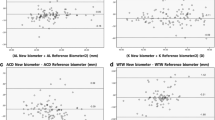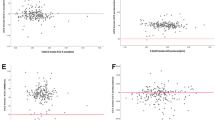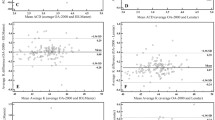Abstract
Purpose
To evaluate the results of optical biometry using the IOLMaster 500, Lenstar LS 900 and Aladdin in eyes with cataract.
Methods
In 231 eyes of 152 patients with cataract, the measurements of 3 different biometers were retrospectively compared. Paired comparisons were performed for axial length (AL), mean keratometry (mean K) and anterior chamber depth (ACD).
Results
In only 197 of the 231 eyes (85.3%), it was possible to obtain reliable measurements of AL with all the three devices. It was not possible to determine AL in 16 eyes (6.9%) with Lenstar LS 900; in 19 eyes (8.2%) with Aladdin; and in 20 eyes (8.6%) with IOLMaster 500 possibly related to the severity of lens opacification (the corneas had good transparency in the eyes included in the study). There was a statistically significant difference in AL between IOLMaster 500 and the remaining two biometers (P = 0.03). However, the amount of difference was considered clinically not significant (0.04 mm). The mean keratometry (mean K) was determined in 203 eyes (87.9%) with all the three devices. Differences in mean K were between − 0.1 and 0.06 Diopters (D), which were considered neither statistically (P > 0.05) nor clinically significant. The anterior chamber depth (ACD) was determined in 197 eyes (85.28%) with all the three biometers. The differences between the three devices (0.03 to 0.13 mm) were not statistically significant and considered also clinically not significant.
Conclusions
There were no clinically significant differences between these 3 biometers in AL, mean K and ACD.



Similar content being viewed by others
References
Haigis W, Lege B, Miller N, Schneider B (2000) Comparison of immersion ultrasound biometry and partial coherence interferometry for intraocular lens calculation according to Haigis. Graefes Arch Clin Exp Ophthalmol 238:765–773
Kiss B, Findl O, Menapace R, Wirtitsch M, Drexler W, Hitzenberger CK et al (2002) Biometry of cataractous eyes using partial coherence interferometry: clinical feasibility study of a commercial prototype I. J Cataract Refract Surg 28:224–229
Nazm N, Chakrabarti A (2017) Update on optical biometry and intraocular lens power calculation. TNOA J Ophthalmic Sci Res 55:196–210
Holzer MP, Mamusa M, Auffarth GU (2009) Accuracy of a new partial coherence interferometry analyser for biometric measurements. Br J Ophthalmol 93:807–810
Sahin A, Hamrah P (2012) Clinically relevant biometry. Curr Opin Ophthalmol 23:47–53
Buckhurst PJ, Wolffsohn JS, Shah S, Naroo SA, Davies LN, Berrow EJ (2009) A new optical low coherence reflectometry device for ocular biometry in cataract patients. Br J Ophthalmol 93:949–953
Epitropoulos A (2014) Axial length measurement acquisition rates of two optical biometers in cataractous eyes. Clin Ophthalmol 8:1369–1376
Mandal P, Berrow EJ, Naroo SA, Wolffsohn JS, Uthoff D, Holland D et al (2014) Validity and repeatability of the Aladdin ocular biometer. Br J Ophthalmol 98:256–258
Salouti R, Nowroozzadeh MH, Zamani M, Ghoreyshi M, Salouti R (2011) Comparison of the ultrasonographic method with 2 partial coherence interferometry methods for intraocular lens power calculation. Optometry 82:140–147
Shajari M, Lehmann UC, Kohnen T (2016) Comparison of corneal diameter and anterior chamber depth measurements using 4 different devices. Cornea 35:838–842
Hill W, Angeles R, Otani T (2008) Evaluation of a new IOLMaster algorithm to measure axial length. J Cataract Refract Surg 34:920–924
Freeman G, Pesudovs K (2005) The impact of cataract severity on measurement acquisition with the IOLMaster. Acta Ophthalmol Scand 83:439–442
Rajan MS, Keilhorn I, Bell JA (2002) Partial coherence laser interferometry vs conventional ultrasound biometry in intraocular lens power calculations. Eye (Lond) 16:552–556
Németh J, Fekete O, Pesztenlehrer N (2003) Optical and ultrasound measurement of axial length and anterior chamber depth for intraocular lens power calculation. J Cataract Refract Surg 29:85–88
McAlinden C, Wang Q, Pesudovs K, Yang X, Bao F, Yu A et al (2015) Axial Length Measurement Failure Rates with the IOLMaster and Lenstar LS 900 in Eyes with Cataract. PLoS ONE 10:e0128929
Mylonas G, Sacu S, Buehl W, Ritter M, Georgopoulos M, Schmidt-Erfurth U (2011) Performance of three biometry devices in patients with different grades of age-related cataract. Acta Ophthalmol 89:e237
Stattin M, Zehetner C, Bechrakis NE, Speicher L (2015) Comparison of IOL-Master 500 vs. Lenstar LS900 concerning the calculation of target refraction: a retrospective analysis. Ophthalmologe 112:444–450
Shammas HJ, Ortiz S, Shammas MC, Kim SH, Chong C (2016) Biometry measurements using a new large-coherence-length swept-source optical coherence tomographer. J Cataract Refract Surg 42:50–61
Akman A, Asena L, Güngör SG (2016) Evaluation and comparison of the new swept source OCT-based IOLMaster 700 with the IOLMaster 500. Br J Ophthalmol 100:1201–1205
Goebels S, Pattmöller M, Eppig T, Cayless A, Seitz B, Langenbucher A (2015) Comparison of 3 biometry devices in cataract patients. J Cataract Refract Surg 41:2387–2393
Gao R, Chen H, Savini G, Miao Y, Wang X, Yang J et al (2017) Comparison of ocular biometric measurements between a new swept-source optical coherence tomography and a common optical low coherence reflectometry. Sci Rep 7:2484
Hoffer KJ, Shammas HJ, Savini G (2010) Comparison of 2 laser instruments for measuring axial length. J Cataract Refract Surg 36:644–648
Hua Y, Qiu W, Xiao Q, Wu Q (2018) Precision (repeatability and reproducibility) of ocular parameters obtained by the Tomey OA-2000 biometer compared to the IOLMaster in healthy eyes. PLoS ONE 13:e0193023
Kunert KS, Peter M, Blum M, Haigis W, Sekundo W, Schütze J et al (2016) Repeatability and agreement in optical biometry of a new swept-source optical coherence tomography-based biometer versus partial coherence interferometry and optical low-coherence reflectometry. J Cataract Refract Surg 42:76–83
Turczynowska M, Koźlik-Nowakowska K, Gaca-Wysocka M, Grzybowski A (2016) Effective ocular biometry and intraocular lens power calculation. European Ophthalmic Review 10:94–100
Hoffer KJ, Shammas HJ, Savini G, Huang J (2016) Multicenter study of optical low-coherence interferometry and partial-coherence interferometry optical biometers with patients from the United States and China. J Cataract Refract Surg 42:62–67
McAlinden C, Wang Q, Gao R, Zhao W, Yu A, Li Y, Guo Y, Huang J (2017) Axial length measurement failure rates with biometers using swept-source optical coherence tomography compared to partial-coherence interferometry and optical low-coherence interferometry. Am J Ophthalmol 173:64–69
Higashiyama T, Mori H, Nakajima F, Ohji M (2018) Comparison of a new biometer using swept-source optical coherence tomography and a conventional biometer using partial coherence interferometry. PLoS ONE 13:e0196401
Savini G, Hoffer KJ, Shammas HJ, Aramberri J, Huang J, Barboni P (2017) Accuracy of a new swept-source optical coherence tomography biometer for IOL power calculation and comparison to IOLMaster. J Refract Surg 33:690–695
Altman DG, Bland JM (1983) Measurement in medicine: the analysis of method comparison studies. Statistician 32:307–317
Bland JM, Altman DG (1986) Statistical methods for assessing agreement between two methods of clinical measurement. Lancet 1:307–310
Bland JM, Altman DG (1999) Measuring agreement in method comparison studies. Stat Methods Med Res 8:135–160
Giavarina D (2015) Understanding Bland Altman analysis. Biochem Med (Zagreb) 25:141–151
Author information
Authors and Affiliations
Corresponding author
Ethics declarations
Conflict of interest
All authors declare that they do not have any conflict of interest.
Ethical approval
All procedures performed in studies involving human participants were in accordance with the ethical standards of the institutional ethical committee and with the 1964 Helsinki declaration and its later amendments or comparable ethical standards. Informed consent was obtained from all individual participants included in the study.
Rights and permissions
About this article
Cite this article
Ortiz, A., Galvis, V., Tello, A. et al. Comparison of three optical biometers: IOLMaster 500, Lenstar LS 900 and Aladdin. Int Ophthalmol 39, 1809–1818 (2019). https://doi.org/10.1007/s10792-018-1006-z
Received:
Accepted:
Published:
Issue Date:
DOI: https://doi.org/10.1007/s10792-018-1006-z




